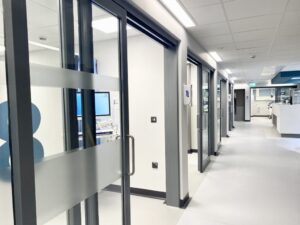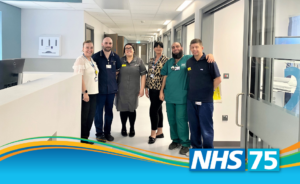Building a better hospital and improving services for patients has been a theme throughout the 75 years of the NHS at Blackpool Victoria Hospital.
The Whinney Heys Road site is almost unrecognisable from the building the NHS took over in 1948 with many expansions and extensions such as the opening of the maternity unit in 1974, replacing Glenroyd on Whitegate Drive, to the opening of the £53m Lancashire Cardiac Centre in 2006.
More recently, the £25m development of an “emergency village” saw a new-build 16-bed Critical Care Unit and Same Day Emergency Care (SDEC) unit opened in summer last year.
The first Emergency Department (ED) refurbishment phase opened last month with improvements that include the first 13 new individual majors cubicles with all the monitoring equipment to give safe and effective care, and two specially designed rooms for high-risk patients with mental health issues. The refurbishment continues with a further nine majors cubicles due for completion in July.
There is also now in use a home for the new CT scanner and three x-ray rooms dedicated to supporting ED flow with plain film x-ray, chest x-ray and specialist CT cone beam capacity.
 The move to this new Assessment A space is allowing further improvements which will be further supported by a six-bay resuscitation area, relative support accommodation and a rapid assessment and triage unit that will double current capacity. It is expected that the complete ED refurbishment will be fully operational by Christmas.
The move to this new Assessment A space is allowing further improvements which will be further supported by a six-bay resuscitation area, relative support accommodation and a rapid assessment and triage unit that will double current capacity. It is expected that the complete ED refurbishment will be fully operational by Christmas.
General X-Ray Manager Jo Peacock said: “It’s very exciting for us as a team. We have taken every step to provide excellent quality imaging to aid fast accurate diagnosis for patients, but also with the health and safety of our staff in mind.
“We have also bought a state-of-the-art dental kit and are one of the very few hospitals in the country to have this cone beam CT. This will aid maxillofacial doctors with diagnosis without the patient having to undergo a high-dose CT imaging. It allows the radiographers to undertake 2D and 3D facial and dental images using low doses to safeguard patient health.”
Sarah Senior, Acting Managing Director of Atlas, which has managed the scheme, added: “Atlas is privileged to continue to work alongside the clinical teams in the delivery of the Emergency Village project. As we hand each phase of the development over to the Trust, you can see the final picture forming as each element comes together to create a state-of-the-art facility fit for modern emergency care.”
